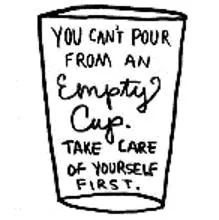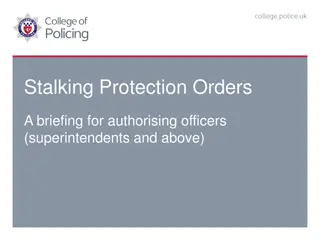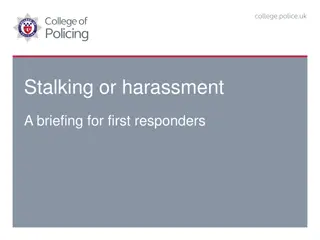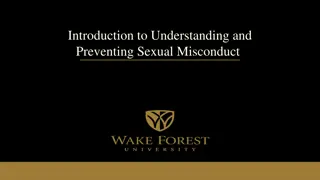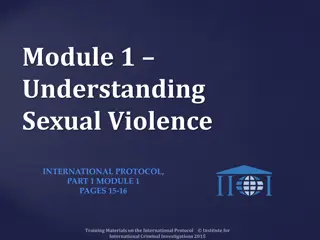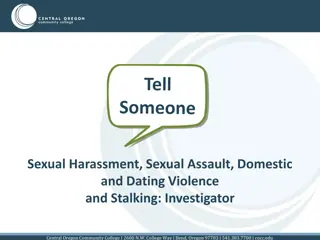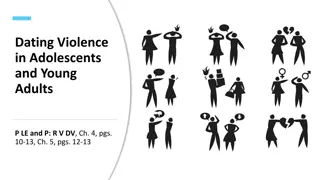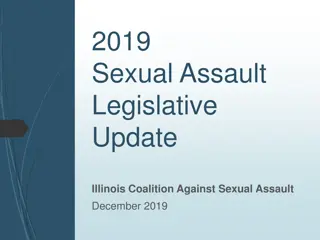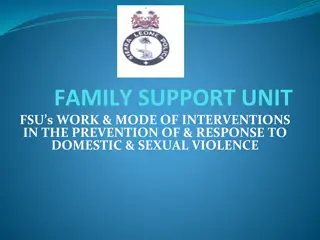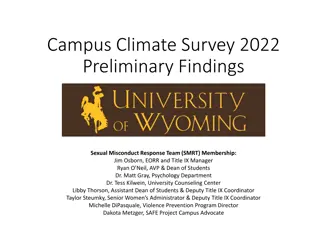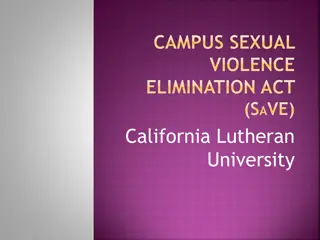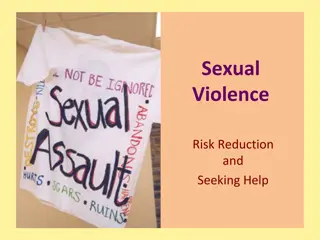Understanding and Addressing Domestic Violence, Dating Violence, Sexual Assault, and Stalking
This training series focuses on raising awareness about domestic violence, dating violence, sexual assault, and stalking. Participants will learn how to recognize crisis and trauma, respond appropriately to disclosures, and create supportive environments for survivors. The sessions cover key topics such as dynamics of violence, trauma-related behaviors, and available resources for survivors and staff.
Download Presentation

Please find below an Image/Link to download the presentation.
The content on the website is provided AS IS for your information and personal use only. It may not be sold, licensed, or shared on other websites without obtaining consent from the author. Download presentation by click this link. If you encounter any issues during the download, it is possible that the publisher has removed the file from their server.
E N D
Presentation Transcript
Introduction to Domestic Violence, Dating Violence, Sexual Assault and Stalking MassHousing TAP Management Training Series 2021 Jessica Santana & Cesia Sanchez Casa Myrna November 18, 2021 Original training developed in partnership with Casa Myrna & Boston Area Rape Crisis Center (BARCC)
Agenda Goals (5 minutes) Overview, definitions and statistics (55 minutes) Break (5 minutes) Understanding and responding to crisis and trauma (35 minutes) Responding to disclosure; resources for survivors and management staff (25 minutes)
Understand sexual violence and the dynamics of domestic and dating violence Identify crisis- and trauma-related behaviors and learn appropriate responses Strengthen capacity to respond to disclosure of sexual and domestic violence and create trauma informed housing environments Understand resources available to survivors and housing staff
1. Remain on mute to minimize background noise. Press the raise hand button to ask a question or type in the chat. 2. Respect confidentiality of all participants 3. Respect all participants ideas or reactions; no comment is bad. The goal is to help us identify our beliefs and prejudices in order to set them aside 4. Self-care!
Language Abuser/batterer/perpetrator Victim/battered woman/survivor Inclusivity oVictim not always she oPerpetrator not always he Tip: Mirror the language the survivor uses
Roles & Responsibilities Resident Service Coordinator DV/SA Advocate Maintenance Provider Property Manager Non-DV/SA Service Provider
In the chat, introduce yourself, your role, and one thing you hope to take away from today s training
Overview, Definitions and Statistics: Sexual violence Domestic and dating violence Intersection with housing instability and poverty Domestic violence: obstacles to leaving Language
What is sexual violence? Any sexual activity where consent is not obtained or freely given. The term defines a broad continuum of violent and abusive behaviors including, but not limited to: rape, sexual assault, sexual harassment and non-contact sexual abuse such as verbal or cyber harassment. Massachusetts Sexual Violence Prevention Plan (2009 2016)
What is Consent? Freely Given Reversible Informed Specific
What is domestic/dating violence? Domestic/dating violence (DV) is a pattern of behavior in a relationship where one person tries to gain and maintain power and control over another.
Abuse, a pattern of coercive behaviors, is the tool one person uses to establish and maintain that power and control. Abuse helps to control the way a person acts, thinks, and feels. Abuse makes a person fearful and isolated from help and resources.
Domestic/dating violence: forms of abuse Abuse takes many forms, including: Physical Verbal Emotional/psychological Financial Sexual Cultural/identity abuse
Physical Verbal Cultural/Identity Emotional/psychological Financial Sexual destroying credit
Abuse model 1: cycle of violence Ok/normal Honeymoon/ Hearts and Flowers Tension Explosion
Abuse model 2: wave of violence Increasingly abusive behavior Respectful behavior
What is stalking? Stalking is the repeated following and harassing of another person that would cause a reasonable person to fear for their safety or the safety of others or suffer substantial emotional distress. It is generally composed of a series of actions that taken individually might seem harmless.
Intersection with housing instability & poverty Safety concerns Fear Moving costs Relocation Sexual & domestic violence (SDV) Financial costs educational performance earnings Economic instability Difficulty affording housing Homelessness
Sexual violence and housing instability Nearly 6 out of 10 sexual assault incidents are reported by victims to have occurred in their own home or at the home of a friend, relative, or neighbor.(US Department of Justice) Nearly 80% of victims living in public housing wanted to relocate because the perpetrator was nearby but could not. (National Sexual Violence Resource Center)
Sexual violence and poverty For survivors of sexual violence who are also struggling economically, the lack of choices often traps them in unsafe situations and relationships in which they may be dependent on their perpetrators for basic goods, such as shelter, food, medicine, transportation, healthcare, childcare, and others. (Pennsylvania Coaltion Against Rape) o Between 70 and 90% of survivors served by PA rape crisis centers are on public assistance and/or struggling to meet basic needs including affordable housing. (PCAR Study)
DV, housing instability and poverty The need for safe housing and economic resources to maintain safe housing are two of the most pressing concerns among DV survivors who are planning to or have recently left abusers. (Clough, A., Draughon, J.E. et al. 2014. Qualitative Social Work, 13(5).) More than a third (38%) of DV survivors report becoming homeless immediately after separating from their partners. (Baker, C.K., Cook, S.L. et al. 2003. Violence Against Women, 9.)
Domestic violence: obstacles to leaving FEAR! Leaving is dangerous; highest risk of homicide is immediately after ending an abusive relationship Economic dependency Children, wanting to keep the family together Religious beliefs Isolation and lack of resources Hoping for a change Love
#whyIstayed Private Violence Presents: Why We Stayed #whyIstayed Huffington Post article (9/9/14) and twitter feed
Discussion: #whyistayed As resident service coordinators, property managers, and facilities staff how does a survivor staying affect you and your property?
Understanding and responding to crisis and trauma: Crisis vs. traumatic events Neurobiology of trauma Trauma responses/triggers Trauma informed responses and spaces Secondary trauma
Crisis Temporary disruption of stability Can be positive or negative events Time-limited response to specific event Normal coping mechanisms do work We all experience occasional crisis
Traumatic events Outside the range of normal human experience Includes threats to life and/or physical, emotional or spiritual integrity Experienced as overwhelming/incomprehensible Feeling powerless or unable to control environment common
Neurobiology of trauma What is going on in there? Instinctual/brain stem Emotional/limbic Rational/cerebral-cortex From the Boston Public Health Commission, 2017.
Instinctual brain: brain stem Everything is NOW! Keeps us safe and alive Automatic reactions oBlood circulation oMuscle contractions oTemperature regulation oBreathing, sleeping, eating From the Boston Public Health Commission, 2017.
Emotional brain: limbic system Site of emotions Site of memory storage Automatic reactions: first alert alarm system in times of stress and crisis From the Boston Public Health Commission, 2017.
Rational or thinking brain: cerebral cortex Has a sense of linear time Is conscious and alert o Observes, anticipates, plans, responds o Makes logical decisions Integrates the other parts of the brain Trauma is thought to disorder the normal functioning of the cerebral cortex From the Boston Public Health Commission, 2017.
Trauma responses Feelings Isolation Distrust Flashbacks Return to Normalcy Hyper-Vigilance Disordered Eating Substance Use Hopelessness Inability to Focus Irritability Coping Skills Supportive Network How might these feelings be triggered by housing instability/ safety concerns? Shame/Self Blame Anxiety/Stress Anger Fear Sadness Powerlessness Denial Confusion Triggered Healing Strong/Resilient What might these behaviors look like and how might they be responded to by providers?
Trauma response: feelings How might the survivor's feelings be triggered by housing instability? Self blame: I should have known to not get myself into this unsafe situation. I should not have let him into my room. Anger: Upset at having no immediate transfer options. Fear: Of not being believed if tenant shares their situation with landlord. Powerlessness: Lack of control over transfer timeline, lack of financial means to address the back rent needs. Triggered: Staying in the same housing unit where incident occurred.
Trauma response: behaviors What might these behaviors look like? Hyper-Vigilance: Putting extra barricades on their doors, clothes in their windows for extra security measures Substance Use: Violating housing no smoking policies, cigarette smoke/ alcohol smell in their non-smoking units Distrust: Not reaching out for support until much later after the incident How might providers respond to them?
Potential triggers Not offering/providing a private space for tenant to discuss their situation. E.g., Meeting in an open office space where all the other staff or tenants may hear. Not giving tenants advance notice if accessing their housing unit is necessary for maintenance purposes. Asking tenants personal questions. E.g., Do you have a boyfriend .
Potential triggers Not giving an explanation of the policies and limitations around addressing the tenant s housing needs. E.g., Read the terms of your lease. The information is all in there. or just dropping off information under their door. Not showing a willingness/effort to understand and help around tenant s situation. E.g., Sorry I cannot help or using non-verbal cues (staff rolling their eyes when tenant discloses).
Potential triggers Not believing the tenant. E.g., We ve heard the same story before Not returning calls or no option to leave a voicemail. Not giving space to explain the situation and alternatives to address need. E.g., I need you to pay the rent back by the end of this month and if not we ll begin eviction proceedings.
Secondary or vicarious trauma Identify it Self care!!! Resources oLaura van Dernoot Lipsky, The Trauma Stewardship Institute, traumastewardship.com oNational Center for PTSD at the U.S. Department of Veterans Affairs, www.ptsd.va.gov
Trauma exposure response (van Dernoot Lipsky, 2009) Feeling helpless and hopeless Sense that one can never do enough Hypervigilance Diminished creativity Inability to embrace complexity Minimizing Chronic exhaustion/physical ailments Inability to listen/deliberate avoidance Dissociative moments Sense of persecution Guilt Fear Anger and cynicism Inability to empathize/ numbing Addictions Grandiosity
Trauma informed responses and spaces Clear understanding and explanation of policies, regulations, limitations Ability to make exemptions and accommodations Believe survivors Private space for resources, phone, support Offer space and time to engage client Staff training and support Referral to appropriate resources








